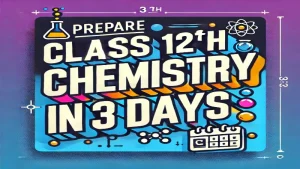Periodic Classification of Elements MCQ Question
Q1) Which of the following forms the basis of the modern periodic table?
- a) Atomic mass
- b) Atomic number
- c) Number of nucleons
- d) All of the above
Show Answer
Correct Answer: Option (b)
Q2) Which of the following is the most reactive element of group 17?
- a) Oxygen
- b) Sodium
- c) Fluorine
- d) Magnesium
Show Answer
Correct Answer: Option (c)
Q3) Which of the following is the correct order of the atomic radii of the elements oxygen, fluorine and nitrogen?
- a) O < F < N
- b) N < F < O
- c) O < N < F
- d) F < O < N
Show Answer
Correct Answer: Option (d) atomic size decreases from left to right.
Q4) What happens to the electropositive character of elements on moving from left to right in a periodic table?
a) Increase
b) Decreases
c) First increases, then decreases
d) First decreases, then increases
Show Answer
Correct Answer: Option (b)
Q5) What is the other name for group 18th elements?
a) Noble gases
b) Alkali metals
c) Alkali earth metals
d) Halogens
Show Answer
Correct Answer: Option (a)
Name of the eight groups in the periodic table:
- Alkali metals – 1
- Alkaline earth metals – 2
- Rare earth metals
- Crystallogens – 14
- Pnictogens – 15
- Chalcogens – 16
- Halogens -17
- Noble gases 18
- transition metals – 2 to 12
Q6) The electronic configuration of an element M is 2, 8, 4. In the modern periodic table, the element M is placed in
a) 4th group
b) 2nd group
c) 14th group
d) 18th group
Show Answer
Correct Answer: Option (c)
Q7) Which of the following elements has 2 shells, and both are completely filled?
a) Helium
b) Neon
c) Calcium
d) Boron
Show Answer
Correct Answer: Option (b)
Q8) Which of the following option describes the achievements of Mendeleev’s Periodic Table?
(a) Prediction of noble gases
(b) It eliminated the blank spaces left in the table
(c) Predicting that the elements can be arranged based on their properties
(d) An element in a trend has an average atomic mass of the elements above and below it
Show Answer
Correct Answer: Option (a)
Q9) Boron is a non-metal and is placed under group 13 and period 2. How can boron form bonds with other elements?
(a) By sharing 5 electrons
(b) By sharing 3 electrons
(c) By sharing 2 electrons
(d) By sharing 1 electron
Show Answer
Correct Answer: Option (b)
Q10. How does the electronegativity of elements vary across the periods?
(a) It increases as the number of shells increases
(b) It decreases as the number of shells decreases
(c) It increases as more electrons are added to the same shell
(d) It decreases as more electrons are added to the same shell
Show Answer
Correct Answer: Option (c)
Q11) What is the order of the metallic character down the group?
(a) It decreases as new shells are added to the element
(b) It increases as electrons move away from the nucleus
(c) It increases as new atoms are added to the same shell
(d) It decreases as the effective nuclear charge on the electron increases
Show Answer
Correct Answer: Option (b)
Q12) What is the trend of valency along the periods in the modern periodic table?
(a) It increases from left to right
(b) It decreases from right to left
(c) It increases and then decreases
(d) It decreases and then increases
Show Answer
Correct Answer: Option (c)
Q13. Newlands relation is called
(a) Musical Law
(b) Law of Octaves
(c) Periodic Law
(d) Atomic Mass Law
Show Answer
Answer: b Upto Ca element, the Law of Octaves was found applicable
Q14. In Mendeleev’s Periodic Table, gaps were left for the elements to be discovered later. Which of the following elements found a place in the Periodic Table later?
(a) Chlorine
(b) Silicon
(c) Oxygen
(d) Germanium
Show Answer
Answer: d
At the time of Mendeleev, the number of elements known was
Q15. An atom of an element has the electronic confi-guration 2,8,2. To which group does it belong?
(a) 4th group
(b) 6th group
(c) 3rd group
(d) 2nd group
Show Answer
Answer: d







